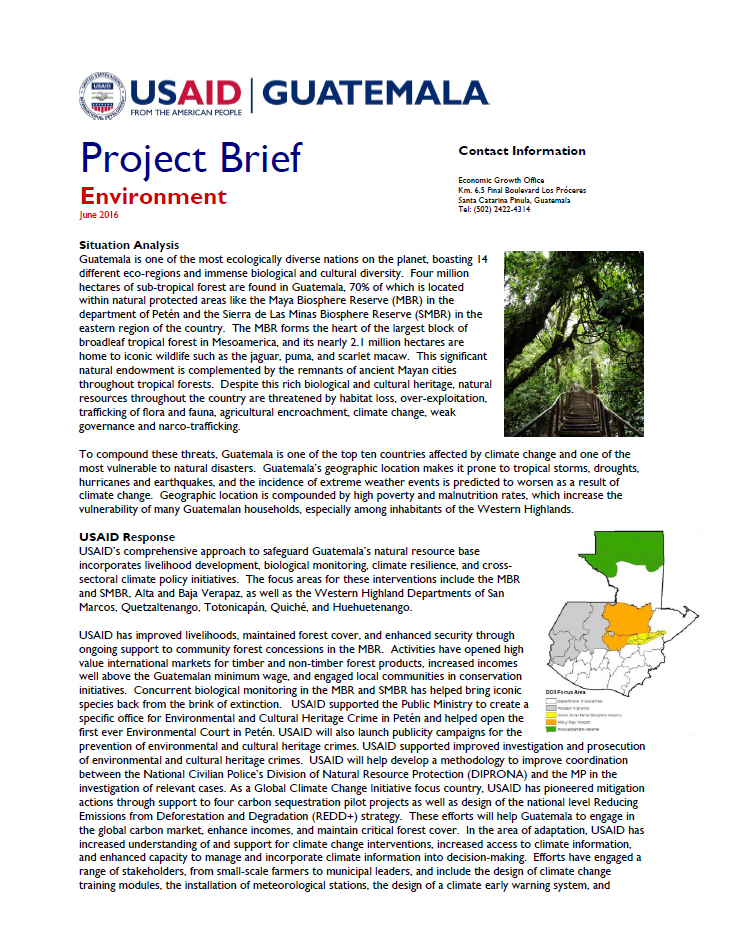Situation Analysis
Sector Brief - Environment ![]() (pdf - 149k)
(pdf - 149k)
Environmental issues are critical in Guatemala because of the country’s vast natural resources. Guatemala is one of the most ecologically diverse nations on the planet, with 14 different eco-regions and great biological and cultural diversity. Four million hectares of sub-tropical forest are found in Guatemala, 70% of which are located within natural protected areas like the Maya Biosphere Reserve in the department of Petén and the Sierra de Las Minas Biosphere Reserve in the eastern region of the country. The forested area comprised of northern Guatemala, Belize, and southern Mexico is the largest in Mesoamerica and the second largest contiguous forest in the Americas after the Amazon. These areas however, as well as other parts of Guatemala, face threats related to habitat loss, deforestation, over-exploitation of natural resources, and environmental contamination.
Many of the country’s poor environmental conditions are linked to challenges in enforcing and complying with existing environmental laws. This jeopardizes the future of small and medium-scale rural producers that depend on the management and protection of biodiversity and natural resources for their economic livelihoods.
In addition to these threats, Guatemala is one of the most vulnerable countries to the impacts of climate change which disproportionately affect rural indigenous farmers and exacerbate poor land management practices.
USAID’s Response
In the environment sector, USAID focuses on conserving biodiversity, reducing emissions, and adapting to the impacts of climate change.
- USAID activities focus on biodiversity conservation and monitoring in key natural protected areas in the country, especially the Maya Biosphere Reserve and Sierra de las Minas Biosphere Reserve, to reduce deforestation and protect critical habitat for key species such as the scarlet macaw, jaguars, and spider and howler monkeys.
- USAID also works in the Maya Biosphere Reserve to promote sustainable harvest of timber and non-timber products from multiple-use zones under Forest Stewardship Council certification. This process of certification and sustainable harvest of valuable hardwoods increases incomes for communities, reduces deforestation, and improves the management of these areas.
- USAID coordinates closely with the U.S. Department of the Interior in the Maya Biosphere Reserve on work related to environmental governance and law enforcement capabilities.
- In order to reduce emissions and the rate of increase of atmospheric greenhouse gases that lead to climate change, USAID interventions focus on Reducing Emissions from Deforestation and Degradation of Forests (REDD+). Through REDD+, USAID protects forests to allow them to sequester carbon, and helps develop and implement strategies and policies to reduce emissions, such as the Low Emission Development Strategy (LEDS).
- USAID’s efforts to reduce vulnerability to the impacts of climate change focus on adopting new agricultural practices, watershed protection, developing early warning systems, and integrating adaptation to climate change impacts into municipal plans. USAID’s climate change adaptation efforts are part of the Western Highlands Integrated Program, which focuses on reducing chronic malnutrition and improving food security through the implementation of three Presidential Initiatives – Feed the Future, the Global Health Initiative, and the Global Climate Change Initiative. The Western Highlands Integrated Program seeks to achieve sustainable rural development through parallel focus on agriculture, economic development, health care, education, nutrition, adaptation to the impacts of climate change, local governance, and gender equity. The Integrated Program works in 30 municipalities and more than 2,500 communities in Guatemala’s Western Highlands that suffer from the highest rates of poverty and chronic malnutrition, yet have the potential for economic growth. USAID collaborates with Guatemalan officials and leaders at the community, municipal, departmental, and regional levels to achieve shared goals, especially under Guatemala’s national plan to reduce chronic malnutrition, known as the Zero Hunger Pact.
- USAID/Guatemala currently monitors water quality and watershed health in Lake Atitlan to better understand the lake’s dynamics and contributing factors to the lake’s deterioration.
Principal Results and Accomplishments
USAID’s efforts have resulted in:
- Signed bilateral agreement – The U.S. Ambassador and the Guatemalan Vice President signed a Memorandum of Understanding and Mutual Work Plan for Guatemala’s Low Emission Development Strategy in July 2013.
- Increased sales and employment generation – Certified timber and non-timber forest products generated $3.9 million in income from sales and more than 1,000 jobs in 2013.
- Protected forest resources – Almost 500,000 hectares of timber and non-timber forest products have been maintained under Forest Stewardship Council certification.
Related Links
El clima cambia y La igualdad se adapta
Frontlines: A New Court in Guatemala Tackles Ecocide
Blog: Talking About Parrots on Talk Like a Pirate Day
In Guatemala, People Living Off Forests Are Tasked With Protecting Them









Comment
Make a general inquiry or suggest an improvement.